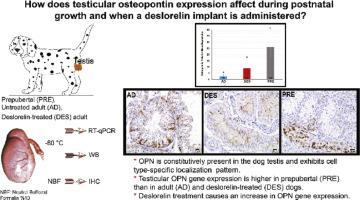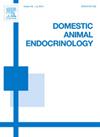Osteopontin expression in prepubertal and adult dog testes and the effect of slow-release deslorelin implants (Suprelorin® 4.7 mg)
IF 2.1
2区 农林科学
Q2 AGRICULTURE, DAIRY & ANIMAL SCIENCE
引用次数: 0
Abstract
Osteopontin (OPN) is a highly phosphorylated glycoprotein expressed in several cells, tissues, and tissue fluids, including the male reproductive system. Recent studies have indicated that OPN may be a potential fertility marker in male dogs. However, OPN expression and localization during testicular growth are still unclear, and the effect of pharmacological castration on testicular OPN expression in male dogs has not been studied to date. This study aimed to investigate and compare the expression and protein immunolocalization of OPN in the prepubertal (PRE) and adult dog (AD) testes, while also evaluating whether treatment of adult dogs (DES) with gonadotropin-releasing hormone (GnRH)-agonist deslorelin (Suprelorin® 4.7 mg implant) could alter the expression of testicular OPN. A significantly elevated OPN gene expression (p ≤ 0.007) was detected in the PRE dogs' testes than in AD and DES dogs. In addition, OPN mRNA expression was higher in DES dogs than in AD (p = 0.002). OPN-immunoreactivity was observed in all groups as granular staining in Sertoli and Leydig cell cytoplasm. Furthermore, in AD dogs, one or sometimes two OPN-positive granules were observed in round spermatids at stage V, and in elongating and elongated spermatids at stages I-III and VI-VIII of the spermatogenic cycle. Our results confirm the presence of OPN in the testes of prepubertal, adult, and deslorelin-induced spermatogenic and steroidogenic arrest dogs and reveal that infertile status, either developmental in PRE or induced in DES, affects testicular OPN expression.

骨桥蛋白在青春期前和成年犬睾丸中的表达及缓释地洛林植入物(superlorin®4.7 mg)的影响
骨桥蛋白(Osteopontin, OPN)是一种高度磷酸化的糖蛋白,在多种细胞、组织和组织液中表达,包括男性生殖系统。最近的研究表明,外阴核可能是雄性犬的潜在生育标志。然而,睾丸生长过程中OPN的表达和定位尚不清楚,药理学去势对雄性犬睾丸OPN表达的影响至今未见研究。本研究旨在研究和比较青春期前(PRE)和成年犬(AD)睾丸中OPN的表达和蛋白免疫定位,同时评估成年犬(DES)使用促性腺激素释放激素(GnRH)激动剂地洛林(superlorin®4.7 mg植入物)是否会改变睾丸OPN的表达。与AD和DES犬相比,PRE犬睾丸中OPN基因表达显著升高(p≤0.007)。此外,DES犬的OPN mRNA表达高于AD犬(p = 0.002)。各组间质和支持细胞均可见opn免疫反应性颗粒染色。此外,在AD犬中,在生精周期的第I-III和第VI-VIII期,在圆形精子中观察到一个或有时两个opn阳性颗粒。我们的研究结果证实了OPN存在于青春期前、成年犬和地斯洛林诱导的生精性和类固醇性阻滞犬的睾丸中,并揭示了无论是PRE发育性还是DES诱导的不育状态都会影响睾丸OPN的表达。
本文章由计算机程序翻译,如有差异,请以英文原文为准。
求助全文
约1分钟内获得全文
求助全文
来源期刊

Domestic animal endocrinology
农林科学-奶制品与动物科学
CiteScore
5.50
自引率
4.80%
发文量
58
审稿时长
31 days
期刊介绍:
Domestic Animal Endocrinology publishes scientific papers dealing with the study of the endocrine physiology of domestic animal species. Those manuscripts utilizing other species as models for clinical or production problems associated with domestic animals are also welcome.
Topics covered include:
Classical and reproductive endocrinology-
Clinical and applied endocrinology-
Regulation of hormone secretion-
Hormone action-
Molecular biology-
Cytokines-
Growth factors
 求助内容:
求助内容: 应助结果提醒方式:
应助结果提醒方式:


